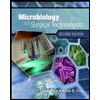
Pearson eText Microbiology: An Introduction -- Instant Access (Pearson+)
13th Edition
ISBN: 9780135789377
Author: Gerard Tortora, Berdell Funke
Publisher: PEARSON+
expand_more
expand_more
format_list_bulleted
Question
Chapter 15, Problem 3MCQ
Summary Introduction
Introduction:
Entry of pathogens to any host or humans through various routes such as mucous membrane or skin termed as portals of entry. Mostly they enter through the mucous membrane of respiratory tract, gastrointestinal tract, genitourinary tract, skin and blood. The pathogens cause various human diseases such as pneumonia, influenza, typhoid fever, giardiasis genital warts, herpes, syphilis conjunctivitis and trachoma etc.
Expert Solution & Answer
Want to see the full answer?
Check out a sample textbook solution
Students have asked these similar questions
What is the structure and function of Eukaryotic cells, including their organelles? How are Eukaryotic cells different than Prokaryotic cells, in terms of evolution which form of the cell might have came first? How do Eukaryotic cells become malignant (cancerous)?
What are the roles of DNA and proteins inside of the cell? What are the building blocks or molecular components of the DNA and proteins? How are proteins produced within the cell? What connection is there between DNA, proteins, and the cell cycle? What is the relationship between DNA, proteins, and Cancer?
Why cells go through various types of cell division and how eukaryotic cells control cell growth through the cell cycle control system?
Chapter 15 Solutions
Pearson eText Microbiology: An Introduction -- Instant Access (Pearson+)
Ch. 15 - Compare pathogenicity with virulence.Ch. 15 - How are capsules and cell wall components related...Ch. 15 - Prob. 3RCh. 15 - Explain how drugs that bind each of the following...Ch. 15 - Prob. 5RCh. 15 - Prob. 6RCh. 15 - Prob. 7RCh. 15 - Which of the following genera is the most...Ch. 15 - How can viruses and protozoa avoid being killed by...Ch. 15 - Prob. 10R
Ch. 15 - The removal of plasmids reduces virulence in which...Ch. 15 - Prob. 2MCQCh. 15 - Prob. 3MCQCh. 15 - All of the following can occur during bacterial...Ch. 15 - The ID50 for Campylobacter sp. is 500 cells; the...Ch. 15 - Prob. 6MCQCh. 15 - A drug that binds to mannose on human cells would...Ch. 15 - The earliest smallpox vaccines were infected...Ch. 15 - Prob. 9MCQCh. 15 - Which of the following statements is true? a. The...Ch. 15 - Prob. 1ACh. 15 - Prob. 2ACh. 15 - Prob. 3ACh. 15 - How do each of the following strategies contribute...Ch. 15 - On July 8, a woman was given an antibiotic for...Ch. 15 - Explain whether each of the following examples is...Ch. 15 - Cancer patients undergoing chemotherapy are...
Knowledge Booster
Learn more about
Need a deep-dive on the concept behind this application? Look no further. Learn more about this topic, biology and related others by exploring similar questions and additional content below.Similar questions
- In one paragraph show how atoms and they're structure are related to the structure of dna and proteins. Talk about what atoms are. what they're made of, why chemical bonding is important to DNA?arrow_forwardWhat are the structure and properties of atoms and chemical bonds (especially how they relate to DNA and proteins).arrow_forwardThe Sentinel Cell: Nature’s Answer to Cancer?arrow_forward
- Molecular Biology Question You are working to characterize a novel protein in mice. Analysis shows that high levels of the primary transcript that codes for this protein are found in tissue from the brain, muscle, liver, and pancreas. However, an antibody that recognizes the C-terminal portion of the protein indicates that the protein is present in brain, muscle, and liver, but not in the pancreas. What is the most likely explanation for this result?arrow_forwardMolecular Biology Explain/discuss how “slow stop” and “quick/fast stop” mutants wereused to identify different protein involved in DNA replication in E. coli.arrow_forwardMolecular Biology Question A gene that codes for a protein was removed from a eukaryotic cell and inserted into a prokaryotic cell. Although the gene was successfully transcribed and translated, it produced a different protein than it produced in the eukaryotic cell. What is the most likely explanation?arrow_forward
- Molecular Biology LIST three characteristics of origins of replicationarrow_forwardMolecular Biology Question Please help. Thank you For E coli DNA polymerase III, give the structure and function of the b-clamp sub-complex. Describe how the structure of this sub-complex is important for it’s function.arrow_forwardMolecular Biology LIST three characteristics of DNA Polymerasesarrow_forward
arrow_back_ios
SEE MORE QUESTIONS
arrow_forward_ios
Recommended textbooks for you
 Comprehensive Medical Assisting: Administrative a...NursingISBN:9781305964792Author:Wilburta Q. Lindh, Carol D. Tamparo, Barbara M. Dahl, Julie Morris, Cindy CorreaPublisher:Cengage LearningEssentials of Pharmacology for Health ProfessionsNursingISBN:9781305441620Author:WOODROWPublisher:Cengage
Comprehensive Medical Assisting: Administrative a...NursingISBN:9781305964792Author:Wilburta Q. Lindh, Carol D. Tamparo, Barbara M. Dahl, Julie Morris, Cindy CorreaPublisher:Cengage LearningEssentials of Pharmacology for Health ProfessionsNursingISBN:9781305441620Author:WOODROWPublisher:Cengage Microbiology for Surgical Technologists (MindTap ...BiologyISBN:9781111306663Author:Margaret Rodriguez, Paul PricePublisher:Cengage Learning
Microbiology for Surgical Technologists (MindTap ...BiologyISBN:9781111306663Author:Margaret Rodriguez, Paul PricePublisher:Cengage Learning


Comprehensive Medical Assisting: Administrative a...
Nursing
ISBN:9781305964792
Author:Wilburta Q. Lindh, Carol D. Tamparo, Barbara M. Dahl, Julie Morris, Cindy Correa
Publisher:Cengage Learning

Essentials of Pharmacology for Health Professions
Nursing
ISBN:9781305441620
Author:WOODROW
Publisher:Cengage

Microbiology for Surgical Technologists (MindTap ...
Biology
ISBN:9781111306663
Author:Margaret Rodriguez, Paul Price
Publisher:Cengage Learning


Infectious Diseases - How do we control them?; Author: Let's Learn Public Health;https://www.youtube.com/watch?v=2JWku3Kjpq0;License: Standard Youtube License